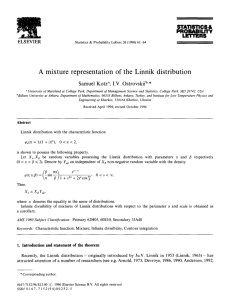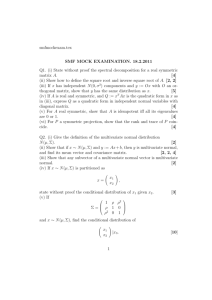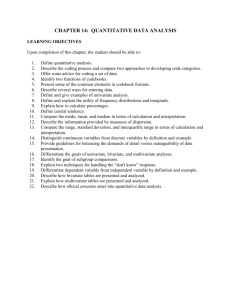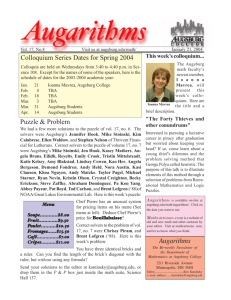LINNIK RELATED DISTRIBUTIONS*
advertisement
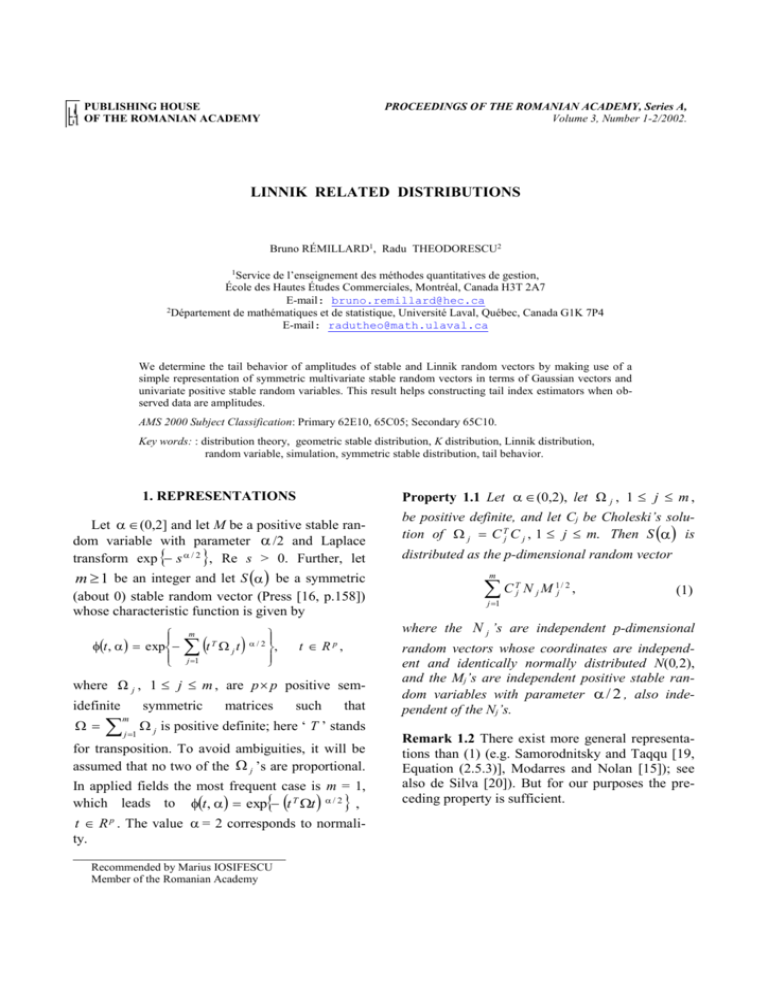
PUBLISHING HOUSE OF THE ROMANIAN ACADEMY PROCEEDINGS OF THE ROMANIAN ACADEMY, Series A, Volume 3, Number 1-2/2002. LINNIK RELATED DISTRIBUTIONS Bruno RÉMILLARD1, Radu THEODORESCU2 1Service de l’enseignement des méthodes quantitatives de gestion, École des Hautes Études Commerciales, Montréal, Canada H3T 2A7 E-mail: bruno.remillard@hec.ca 2Département de mathématiques et de statistique, Université Laval, Québec, Canada G1K 7P4 E-mail: radutheo@math.ulaval.ca We determine the tail behavior of amplitudes of stable and Linnik random vectors by making use of a simple representation of symmetric multivariate stable random vectors in terms of Gaussian vectors and univariate positive stable random variables. This result helps constructing tail index estimators when observed data are amplitudes. AMS 2000 Subject Classification: Primary 62E10, 65C05; Secondary 65C10. Key words: : distribution theory, geometric stable distribution, K distribution, Linnik distribution, random variable, simulation, symmetric stable distribution, tail behavior. 1. REPRESENTATIONS Property 1.1 Let (0,2), let Ω j , 1 j m , Let (0,2] and let M be a positive stable random variable with parameter /2 and Laplace transform exp s / 2 , Re s > 0. Further, let be positive definite, and let Cj be Choleski’s solution of j C Tj C j , 1 j m. Then S is m 1 be an integer and let S be a symmetric (about 0) stable random vector (Press [16, p.158]) whose characteristic function is given by t , exp t m j 1 T jt , /2 symmetric m j 1 matrices tR , such that j is positive definite; here ‘ T ’ stands for transposition. To avoid ambiguities, it will be assumed that no two of the j ’s are proportional. In applied fields the most frequent case is m = 1, which leads to t , exp t T t / 2 , t R p . The value = 2 corresponds to normality. ______________________________ Recommended by Marius IOSIFESCU Member of the Romanian Academy m C T j N j M 1j / 2 , (1) j 1 where the N j ’s are independent p-dimensional p where Ω j , 1 j m , are p p positive semidefinite distributed as the p-dimensional random vector random vectors whose coordinates are independent and identically normally distributed N(0,2), and the Mj’s are independent positive stable random variables with parameter / 2 , also independent of the Nj’s. Remark 1.2 There exist more general representations than (1) (e.g. Samorodnitsky and Taqqu [19, Equation (2.5.3)], Modarres and Nolan [15]); see also de Silva [20]). But for our purposes the preceding property is sufficient. Bruno RÉMILLARD, Radu THEODORESCU 2. SIMULATION For the normal case ( = 2) there exist simulation algorithms. Property 1.1 leads to a simulation algorithm for symmetric stable random vectors by making use of positive univariate stable random variables. Next, we can generate a positive stable random variable by the method proposed by Chambers, Mallows, and Stuck [4] that relies on results in Ibragimov and Chernin [7] and Kanter [12]. Another algorithm for generating a three dimensional symmetric stable random vector is to be found in Uchaikin and Gusarov [21]. A comparative simulation based study of the algorithms in [9] and [21] was done by Boucher [3], who showed the advantages of that in [9]. Since we know how to simulate univariate/multivariate symmetric stable random variables, we are also able to simulate univariate/multivariate Linnik random variables using univariate positive stable random variables. Devroye [5] provided a simple and elegant algorithm for simulating univariate Linnik random variables. In Jacques, Rémillard and Theodorescu [9, p. 217] we indicated an algorithm for the multivariate symmetric case, based on Property 1.1. Recall that for (0,2] , 0 , and the same j ’s, the characteristic function of the multivariate Linnik distribution is given by t , , 1 tT jt j 1 m /2 , t R p. The associated probability density function will depend on x via x T 1 x . For the case = 2 (which is widespread in applied fields) and m = 1, we obtain after some manipulations and for x R p the probability density function f x, 1 2 p 1 p / 2 det x T 1 x 2 1/ 2 p / 2 K p / 2 2 If G( ) is a gamma ( ,1) random variable independent of S( ), then the characteristic function of the random vector: L, S G 1/ is (t , , ) . Consequently, the simulation of L( , ) amounts to the simulation of S and G( ). We also mention the algorithm in Kozubowski [13]. 3.TAIL BEHAVIOR For > 0 we consider the family of all random variables X for which the tail property lim x P X x c x holds, where c is a positive constant, generally depending on and possibly on other parameters. According to Mandelbrot [14], we refer to it as the Paretian family of index . For (0,2), stable random variables (symmetric or not) are Paretian, from which we conclude (Jacques, Rémillard, and Theodorescu [9, pp. 214-216]) that Linnik random variables are also Paretian. We now assume that m = 1. We consider the amplitudes (Euclidean norms) |S | and |L( , )|. In certain applications, the only observed data are such quantities. This is the case in particular for satellite and radar data (Anastassopoulos et al. [1] and Raghavan [18]). Next, we examine the tail behavior of these amplitudes. The following property complements previous results obtained by Jacques, Rémillard, and Theodorescu [9]. Property 3.1 Let (0,2) and q 1 . We denote by V j x, the expression sin j / 2. x T 1 x , which involves the modified Bessel function K of the second kind of order . The last expression clearly links Linnik distributions to K functions. 1 1 j 1 j / 2 x j E N j! j We have lim x q P S x x and V x, 0 q j j 1 (2) 3 Linnik related distributions lim x q x P L, x W j x, 0 j 1 q (3) where W x, V x, ( j ) / (), j j and N is a p-dimensional centered Gaussian vector with covariance matrix 2 . Proof. Property 1.1 implies that S and NM 1 / 2 have the same distribution, where M is a positive stable random variable with parameter /2. Now, consider the tail behavior of M ([9, Proposition 2.2]) or, equivalently, that of M 1/ 2 . If we take into account the effect of multiplication on the asymptotic behavior of the upper tail probability ([9, Lemma 2.1]), then we are led to (2). Applying again the same ‘multiplication’ argument, we obtain (3). When observed data are amplitudes, results such as (2) and (3) together with techniques described in Hall [6] may be used to find estimators for the tail index . Remark 3.2 For q = 1, Property 3.1 implies: lim x P S x A , (4) x sponding Linnik amplitudes have the same law. The same is true for the stable amplitudes. Random variables as L, are related to the so-called K distributions; for 2 and 2 I we obtain the generalized K probability density function (Jakeman and Tough [10, Eq. (2.11)] and Barakat [2]), which can be easily simulated as the product of two independent square roots of gamma variates. Replacing gamma by generalized gamma variates broadens this family, leading to the socalled GC-distributions (Anastassopoulos et al. [1]) used in radar clutter statistics. For many years K distributions have provided promising models in connection with certain problems in electromagnetic scattering from physical media (Raghavan [18]), SAR (synthetic aperture radar) imagining, geophysical remote sensing (Joughin, Percival, and Winebrenner [11]), high resolution radar clutter (Anastasopoulos et al. [1]). Several methods for parameter estimation also exist (Raghavan [17], Joughin, Percival, and Winebrenner [11], Iskander and Zoubir [8]). Additional literature related to K distributions and their application in modeling weak scattering might be found, e.g., in the cited articles. Here we want to emphasize the close link between K and Linnik distributions, which yields relatively simple simulation algorithms and, consequently, less computational manipulations. where A V1 1, and AKNOWLEDGMENT lim x P L, x A . (5) x Hence the amplitudes |S | and |L( , )| are Paretian. Now, if 2 I (I stands for the identity matrix), then A This work was supported by the Natural Sciences and Engineering Research Council of Canada and by the Fonds pour la formation de chercheurs et l’aide à la recherche du Gouvernement du Québec. 2 / 2 p / 2 sin / 2 p / 2 and (4) and (5) can be rewritten accordingly. Remark 3.3 The amplitude |L( , )| REFERENCES 1. was ob- tained from |S | by multiplication with the (1/ )th power of a gamma random variable; in fact, the preceding results hold for any nonnegative random variable which has moments of appropriate orders. Remark 3.4 If denotes the diagonal matrix formed with the eigenvalues of , then the corre- 2. 3. ANASTASSOPOULOS, V., LAMPROPOULOS, G. A., DROSOPOULOS, M., REY, M., High resolution radar clutter statistics. IEEE Trans. Aerospace Electron. Systems 35, pp. 43-60 (1999). BARAKAT, R., Weak-scattered generalization of the K-density function with application to laser scattering in atmospheric turbulence, J. Opt. Soc. Amer. Ser. A 3, pp. 401-409 (1986). BOUCHER, R., Comparaison de deux algorithmes de simulation des lois stables multivariées. Univ. Laval, Dept. Math. Statist. (Manuscript) (2000). Bruno RÉMILLARD, Radu THEODORESCU 4. 5. 6. 7. 8. 9. 10. 11. 12. 13. 14. 15. 16. 17. 18. 19. 20. 21. [CHAMBERS, J. M., MALLOWS, C. L., STUCK, B. W., A method for simulating stable random variables. J. Amer. Statist. Assoc. 71, pp. 340-344 (1976). DEVROYE, L., A note on Linnik’s distribution. Statist. Probab. Lett 9, pp. 305-306 (1990). HALL, P., On some simple estimates of an exponent of regular variation, J. Roy. Statist. Soc. Ser. B 44, pp. 3742 (1982). IBRAGIMOV, I. A., CHERNIN, K. E., On the unimodality of stable laws. Theor. Probab. Appl. 4, pp. 417-419 (1959). ISKANDER, D. R., ZOUBIR, A. M., Estimating the parameters of the K-distribution using the ML/MOM approach. IEEE Trans. Signal Processing 47, pp. 11471151 (1999). JACQUES, C., RÉMILLARD, B., THEODORESCU, R., Estimation of Linnik law parameters. Statist. Decisions 17, pp. 213-235 (1999). JAKEMAN, E., TOUGH, R. J. A., Generalized K distribution: a statistical model for weak scattering. J. Opt. Soc. Amer. Ser. A 4, pp. 1764-1772 (1987). JOUGHIN, I. R., PERCIVAL, D. B., WINEBRENNER, D. P., Maximum likelihood estimation of K distribution parameters for SAR data. IEEE Trans. Geosci. Rem. Sensing 31, pp. 989-998 (1993). KANTER, M., Stable densities under change of scale and total variation inequalities. Ann. Probab. 3, pp. 697707 (1975). KOZUBOWSKI, T., Computer simulation of geometric stable distributions, J. Comput. Appl. Math. 116, pp. 221-229 (2000). MANDELBROT, B., Paretian distributions and income maximization. Quart. J. Econom, 76, pp. 57-85 (1962). MODARRES, R., NOLAN, J. P., A method for simulating stable random vectors. Comput. Statist. 9, pp. 11-19 (1994). PRESS, S. J., Applied multivariate analysis: using Bayestian and frequentist methods of inference, Second Ed. Malabar, Krieger, 1982. RAGHAVAN, R. S., A method for estimating parameters of K-distributed clutter. IEEE Trans. Aerospace Electron. Systems 7, pp. 238-246 (1991). RAGHAVAN, R. S., A model for spatially correlated radar clutter. IEEE Trans. Aerospace Electron. Systems 7, pp. 268-275 (1991). SAMORODNITSKY, G., TAQQU, M., Stable nonGaussian random processes. New York, Chapman & Hall, 1994. DE SILVA, B. M., A class of multivariate symmetric stable distributions. J. Multivariate Anal. 8, pp. 335-345 (1978). UCHAIKIN, V. V., GUSAROV, G. G., Simulation of random vectors from three-dimensional spherically symetric stable distributions. J. Math. Sciences 93, pp. 591599 (1999). Received January 25, 2002 4
